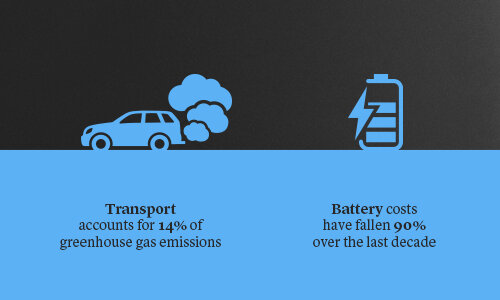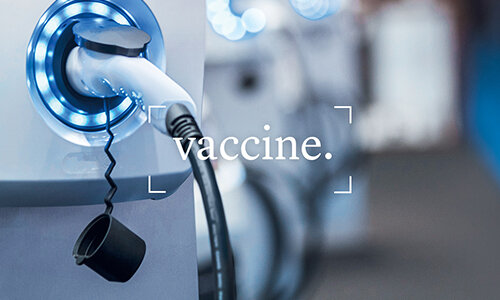Lombard Odier sees significant investment opportunities in the transition to a clean transport system, which could generate, annually, at least $2 trillion in economic benefits.
By Kristina Church, Senior Investment Strategist for Sustainable Investment, Lombard Odier Investment Managers
Our mobility system is out of control. It is Wasteful, Idle, Lopsided and Dirty (WILD). Cars sit unused over 90 percent of the time. Air pollution costs the economy and society at least $3.5 trillion every year – with half of that cost coming from road transport.[1]
The solution is to go from a WILD to a Circular, Lean, Inclusive and Clean (CLIC™) model. This is about electrification - but in combination with alternative fuels for long-haul transport, a change in how we undertake short trips and shifting vehicle ownership to Mobility-as-a-Service (MaaS).
This transition could generate at least $2 trillion in economic benefits every year and is the vaccine to creating a CLIC™ mobility model.
New Habits
Transport accounts for 14 percent of greenhouse gas (GHG) emissions[2] and is one of the few sectors where they have been rising, driven by increasing demand for the movement of goods and people.
However, the impact of lockdowns and reduced mobility during the pandemic could see emissions from road transport fall 14 percent[3] in 2020 and total greenhouse gases (GHG) emissions drop by up to 8 percent[4].
Nevertheless, even with these drops, to meet the most stringent goals of the Paris Agreement by 2050, we urgently need a 7.6 percent reduction in total GHG emissions every year for the next decade. Transport emissions need to almost halve by 2050[5], even as conditions return to 'a new normal'. This means decoupling emissions growth from the increasing demands for the mobility of people and goods – which will be vital for future economic growth.
New mobility habits formed during the current crisis could present a vital opportunity to rethink transport models and reallocate resources to cleaner and leaner transport options.
While electric vehicles are not a new technology - they were first introduced by Ford in 1908 - we believe the 2020s is the decade when electric penetration will explode.

Changing Gears
The disruption of any business model is hard to predict but it took only two decades for the car to replace the horse. Similarly, we expect electric vehicles will disrupt the combustion engine within the next 20 years.
Electric vehicles are a vital solution to decarbonize road transport and are close to a tipping point which is clear through recent advances.
Technology improvements mean that life-cycle emissions are now lower for battery electric vehicles (BEVs) than combustion engine cars (ICE). Battery costs have fallen 90 percent[6] over the past decade and car manufacturers are close to being able to produce BEVs as profitably as ICEs. Sustainable raw material sourcing and end-of-life battery recycling options are also becoming much more widely available[7].
International COVID-19 recovery plans have dedicated investment to EV charging infrastructure and battery sourcing[8]. This will push consumers to become more comfortable with charging requirements and help overcome range-anxiety and supply issues. Increased EV subsidies in many countries, such as Germany[9] and China, are also making the total cost of ownership of electric vehicles much more attractive.
Spreading Trend
The shift towards electric vehicles is also apparent through the actions of the authorities.
Regulations are in place around the world to mitigate tailpipe emissions from cars and force the automotive industry to electrify. Governments whose regulations govern 85 percent of light vehicles now want a ban on ICE vehicles within the next 20 years. There are low-emission zones and bans on older cars in many cities globally as a result of worsening urban air quality, as well as congestion charging and parking restrictions.
The related issue of pollution linked to nitrogen oxide was brought to public attention by 2015’s «Dieselgate» and prompted more cities to focus on pollution and health issues linked to combustion engine cars. Carmakers’ fleet emissions tests were tightened in Europe under the new real-life test cycle (WLTP[10]) and increasingly cities have started to impose ICE bans to try to meet air pollution targets. We can only expect these regulations to tighten. The California Air Resources Board, for instance, has proposed requiring 60 percent of miles travelled by ride-hail passengers be in electric vehicles by 2030. In Paris, Mayor Hidalgo was re-elected this year on the back of her «15-minute city»[11] campaign to discourage car usage.
Electrification is also surging in China and not just in cars. In Nanning, a second-tier city, electric vehicle travel exceeded 34 percent of all transportation in 2019, surpassing public transport and private cars[12].
Meituan, a Chinese conglomerate that owns bike-sharing company Mobike, announced in May 2020 that it is putting several hundreds of thousands of e-bikes on the streets. Qingju has also made expanding its e-bike sharing business a priority for 2020. Hellobike has joined forces with Chinese battery maker CATL to deploy more than one million electric scooters across China with swappable batteries.

Faster Adaption
We believe current vehicle forecasts significantly underestimate the tipping point for electric vehicle penetration.
Many powerful forces are working in combination to push the electric agenda ahead. Regulatory support is accelerating, just as green vehicle technology is becoming cheaper. Equally, investors are aware of multiple opportunities along the entire electric vehicle supply chain and consumers are encouraged by local regulations to drive more sustainably.
At Lombard Odier, we see the CLIC™ mobility revolution as creating significant investment opportunities.
Electric vehicles and their supply chain will gain market share much faster than many predict.
The clean transport transition must come in combination with leaner, more circular and more inclusive transport options – aided by alternative transport modes, alternative fuels and alternative ownership structures.
This article was originally published on Lombard Odier’s website here. For more insights from Lombard Odier on sustainability and on why the world needs to shift towards a Circular, Lean, Inclusive and Clean model, head over to their Sustainability Hub.
[1] Organization for Economic Co-operation and Development (OECD), 2014: The Cost of Air Pollution: Health Impacts of Road Transport
[2] See PDF “CLIC™” Mobility: A Climate Transition for Transport in a Post-COVID World
[3] BNEF Electric Vehicle Outlook 2020, 19 May 2020.
[4] International Energy. Accessed at: https://www.iea.org/reports/global-energy-review-2020/global-energy-and-co2-emissions-in-2020 and Bloomberg Green, Biggest Fall in Global Emissions Shows the Limits of Individual Action, 19/5/2020.
[5] Idem
[6] Bloomberg New Energy Finance (BNEF)
[7] For instance, Swedish battery cell manufacturer Northvolt has recently launched Revolt, its battery cell recycling program and targets 50% recycled material in new cells within the next decade https://northvolt.com/newsroom/Announcing-Revolt
[8] https://autovistagroup.com/news-and-insights/green-recovery-automotive-industry
[9] https://www.electrive.com/2020/06/04/germany-doubles-ev-subsidies-no-more-diesel-support/
[10] https://www.sciencedirect.com/science/article/pii/S2352146517306403
[11] Forbes (2020). Every street in Paris to be cycle-friendly by 2024, promises Mayor.
[12] https://www.weforum.org/agenda/2020/07/4-big-bike-sharing-trends-from-china-that-could-outlast-covid-19/











